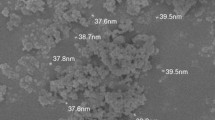Abstract
Two-phase flows of LiBr water solution in minichannels with heat exchange is experimentally investigated. Six flow patterns have been revealed: a bubble flow, plug flow, separate and wavy separate flow, dispersed flow, and flow blocking. Contrary to one-component liquids, an additional third phase may appear in desorption of salt solutions, that is, a crystal-hydrate shell on channel walls. The maximum desorption efficiency corresponded to minichannels of 3 mm in diameter and in the presence of a dispersed flow. The desorption rate depends not only on the ratio of liquid, gas, and heat flux velocities, but also on the overall interface area. The maximal interfacial evaporation surface corresponds to the dispersed flow due to the presence of a high concentration of fine-dispersed droplets. Minichannels with a high desorption rate can be effectively applied for high-temperature desorbers of thermal pumps.
Similar content being viewed by others
References
Schmidt, R., Challenges in Electronic Cooling—Opportunities for Enhanced Thermal Management Techniques—Microprocessor Liquid Cooled Minichannel Heat Sink, Proc. First Int. Conf. onMicrochannel and Minichannels, USA, Rochester, 2003.
Bar-Cohen, A., Sherwood, G., Hodes, M., and Solbreken, G.L., Gas-Assisted Evaporative Cooling of High Density Electronic Modules, IEEE Trans. CPMT, pt. A, 1995, vol. 18, pp. 502–510.
Kabov, O.A., Kuznetsov, V.V., and Legros, J-C., Heat Transfer and Film Dynamic in Shear-Driven Liquid Film Cooling System of Microelectronic Equipment, Proc. Second Int. Conf. on Microchannel and Minichannels, USA, Rochester, ASME, 2004.
Baker, T., Designing for Simultaneous Flow of Oil and Gas, Oil Gas J., 1954, vol. 53, no. 12, pp. 85–90.
Lin, P.Y. and Hanratty, T.Y., Effect of PipeDiameter on Flow Patterns for Air-Water Flow inHorizontal Pipes, Int. J. Multiphase Flow, 1987, vol. 13, pp. 549–554.
Damianides, C.A. and Westwater, J.W., Two-Phase Flow Patterns in a Compact Heat Exchanger and in Small Tubes, Proc. 2nd UK Nath. Conf. on Heat Transfer, 1988.
Suo, M. and Griffith P., Two-Phase Flow in Capillary Tubes, Trans. ASME, J. Basic Eng. D, 1964, vol. 86, no. 3, pp. 182–187.
Barajast, A.M. and Panton, R.L., The Effect of Contact Angle on Two-Phase Flow in Capillary Tubes, Int. J. Multiphase Flow, 1993, vol. 19, no. 2, pp. 337–342.
Chen, W.L., Twu, M.C., and Pan, C., Gas-Liquid Two-Phase Flow in Microchannels, Int. J. Multiphase Flow, 2002, vol. 28, pp. 1235–1239.
Kawahara, A., Chung, P.M.-Y., and Kawaji, M., Investigation of Two-Phase Flow Pattern. Void Fraction and Pressure Drop in Microchannels, Int. J. Multiphase Flow, 2002, vol. 28, pp. 1411–1417.
Chinnov, E.A. and Kabov, O.A., Two-Phase Flows in Tubes and Capillary Channels, Teplof. Vys. Temp., 2006, vol. 44, no. 5, pp. 777–795.
Hewitt, G.F., Measurement of Two-Phase Flow Parameters, London: Academic, 1978.
Kandikar, S.G., Microchannels and Minichannels-History, Terminology, Classification and Current Research Needs, Proc. First Int. Conf. on Microchannels and Minichannels, UCA, Rochester: ASME, 2003.
Kuznetsov, V.V., Dimov, S.V., Shamirzaev, A.S., Houghton, P.A., and Saunder, S., Upflow Boiling and Condensation in Rectangular Minichannels, First Int. Conf. on Microchannels and Minichannels, Kandlikar, S.G., Ed., New York, 2003, pp. 683–689.
Kuznetsov, V.V. and Shamirzaev, A.S., Boiling Heat Transfer for Freon R21 in Rectangular Minichannel, Heat Transfer Eng., 2007, vol. 28, nos. 8/9, pp. 738–745.
Bogatko, T.V., Pakhomov, M.A., Terekhov, V.I., and Shumeiko, A.A., The Influence of Evaporating Droplets on Turbulence and Heat Transfer in a Two-Phase Separated Flow, Theses of Reports, XI Int. Conf. “Zababakhinskii Scientific Readings,” Snezhinsk, RFYaTs-VNIITF, 2012.
Terekhov, V.I. and Pakhomov, M.A., Numerical Study of Heat Transfer in a Laminar Dispersed Flow over an Isothermal Flat Plate, Int. J. Heat Mass Transfer, 2002, vol. 45, no. 10, pp. 2077–2085.
Nakoryakov, V.E., Misyura, S.Y., and Elistratov, S.L., Nonisothermal Desorption of Droplets of Complex Composition, Thermal Sci., 2012, vol. 16, no. 4, pp. 997–1004.
Nakoryakov, V.E. and Grigoryeva, N.I., Neizotermicheskaya absorbtsiya v termotransformatorakh (Nonisothermal Adsorption in Thermotransformers), Novosibirsk: Nauka, 2010.
Nakoryakov, V.E., Misyura, S.Y., and Elistratov, S.L., The Behavior of Water Droplets on the Heated Surface, Int. J. Heat Mass Transfer, 2012, vol. 55, pp. 6609–6617.
Misyura, S.Y., Nucleate Boiling in Bidistillate Droplets, Int. J. Heat Mass Transfer, 2014, vol. 71, pp. 197–205.
Kutateladze, S.S., Osnovy teorii teploobmena (Principles of Heat Transfer Theory), Moscow: Atomizdat, 1979.
Author information
Authors and Affiliations
Corresponding author
Rights and permissions
About this article
Cite this article
Nakoryakov, V.E., Misyura, S.Y., Elistratov, S.L. et al. Two-phase nonisothermal flows of LiBr water solution in minichannels. J. Engin. Thermophys. 23, 257–263 (2014). https://doi.org/10.1134/S1810232814040018
Received:
Published:
Issue Date:
DOI: https://doi.org/10.1134/S1810232814040018




